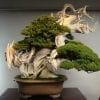Growing and shaping regular trees into a bonsai is not just a hobby but rather more of an art form. Bonsai trees were first grown and cultivated in Asia. The concept of miniaturizing plants and trees as well as preserving natural aesthetic qualities of the plant has been followed for many centuries. There are a number of stand-out bonsai tree species that are worthy of praise. These lovely mini-mighty trees are popular for their beautiful and stately appearance and for their ability to depict balance and realism. If you are thinking of taking up bonsai growing or are looking for inspiration then these awesome bonsai trees could help you out.
1) 800-Year-Old Bonsai Tree at Shunkaen

When properly cared for and cultivated, bonsai trees can grow to as long as 800 and this is exactly what the Bonsai Tree in Shunkaen is all about. This bonsai tree is very popular not just in Japan but also around the world with its striking beauty as well as old age. The Shunkaen bonsai is known to be 800 years old! And if you think that this bonsai species is ready to hit the sack then think again. The Shunkaen bonsai is still growing and thriving till today.
The Shunkaen bonsai is kept in the Shunkaen nursery in Tokyo where it is visited by a large number of visitors year after year. And possibly what’s very special about this bonsai tree is that it is owned none other than the Bonsai Master himself, Kunio Kobayashi. Mr. Kobayashi has dedicated his life to bonsai and has received the Prime Minister Award of Japan three times for his work. The Shunkaen bonsai is just one of his many works and is featured in his nursery for every bonsai grower and aficionado to see and admire.
What sets this bonsai tree apart from other trees is its dramatic presentation. It has a very noticeable twisted white bark which obviously was the product of years upon years of refining. The leaves have been strategically arranged so the plumes are alternately located. The Bonsai Master used a simple shallow green pot. The simple pot does not overshadow the beautiful yet aging tree. It simply lets the bonsai design and lovely natural appearance of your tree stand out. This bonsai tree is in a good state of health and there is no doubt that it will still live for more years to come.
2) Chinese Elm Bonsai
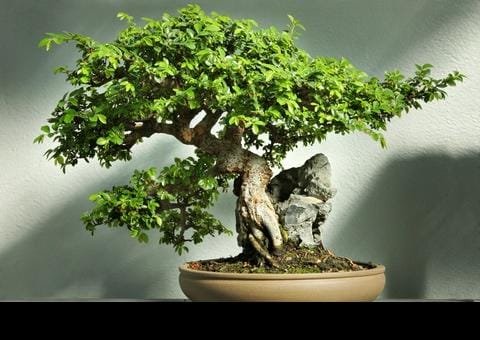
There are two reasons why the Chinese Elm Bonsai is a standout among bonsai tree species. One, it has an enchanting natural beauty that shines no matter what style or design it is in. Second, the Chinese Elm Bonsai is very easy to grow.
The Chinese Elm Bonsai has a distinct reddish-brown bark that will develop a corky or fissure-like surface as the tree matures. It has a natural branching shape with delicate oval-shaped leaves. Most Chinese Elms have thick tufts of leaves that grow in a predictable pattern. This makes this bonsai tree species a favorite among beginners and those who are new to styling and refining bonsai plants.
The Chinese Elm is native to East Asia and can grow up to 65-feet tall in the wild. And if you cultivate this well, this will able to remain healthy, strong and lovely for many years to come. The Chinese Elm is very tolerant to changes in temperature but usually, it does not like drafts or general variations in temperature. Indoor tropical Chinese Elm trees prefer between 60 to 70 degrees Fahrenheit. You can grow a Chinese Elm outdoors but remember to take it inside when the temperature drops below 60 degrees.
Chinese Elm Bonsai trees can be designed to fit almost any bonsai style and these may be achieved by constant pruning and wiring. The tiny leaves of the Chinese Elm may be pruned to encourage new leaf growth. Removing small branches, buds and new growths can be removed all year long to maintain its size. Wiring may also be done at the same time when the trees are pruned but you have to wait once the new shoots have developed a slightly woody appearance.
All-in-all, this bonsai species is a good starting tree for first-time growers and is also lovely to cultivate. And to be able to grow a Chinese Elm Bonsai is indeed something that’s worthy of praise.
3) Blue Japanese Wisteria Bonsai
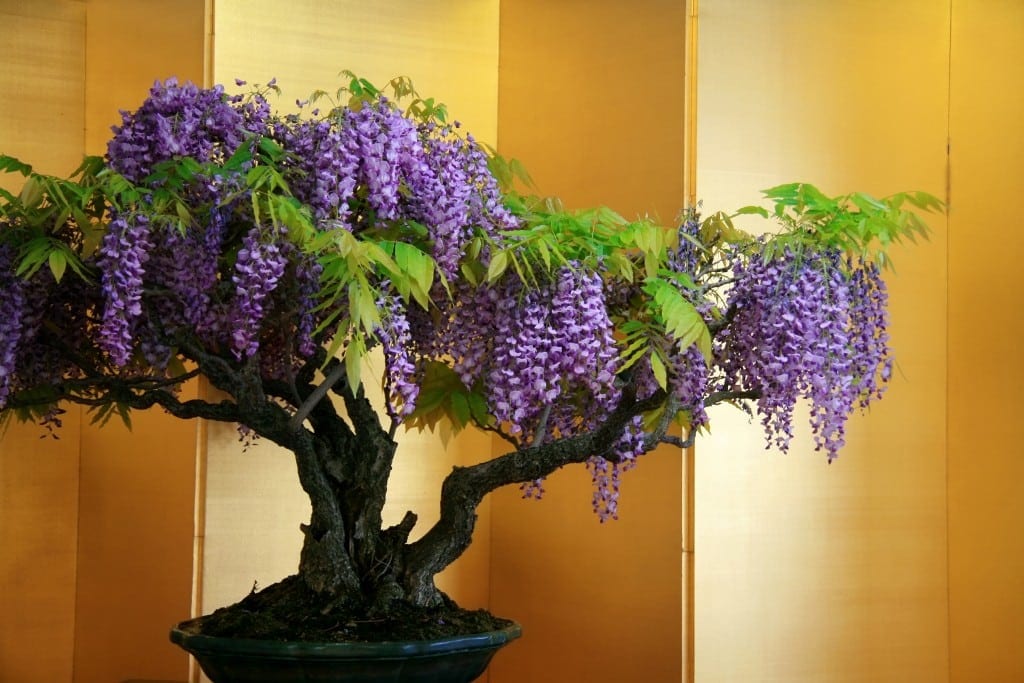
The Blue Japanese Wisteria bonsai is one of the most exotic and the most strikingly beautiful bonsai trees that you can cultivate today. The wisteria is known for its lovely and aromatic flowers that come in a variety of colors: pink, purple, blue and white. In the wild, this tree can grow up to 30 feet in height. And aside from using pruning and wiring techniques to create a Blue Japanese Wisteria bonsai, this tree relies on lots of water, the right kind and the right amounts of fertilizer and adequate drainage are all very important.
What’s striking about the Blue Japanese Wisteria bonsai is its twining and woody trunk and branches. It has long leaves that are perfect for bonsai styling and don’t forget its smaller leaflets that create a lovely layered look. But despite its good features and characteristics, the Wisteria does not conform to normal styling. Usually, Wisterias are styled to let these plants show off it’s scented flowers that can grow up to 30cm long. The blue Wisteria flowers usually appear in late spring or early summers. Later on, this tree will develop pendant bean-shaped pods.
The Blue Japanese Wisteria is indeed very lovely but do you know that it could be very hard to make a Wisteria flower in bonsai form? Wisteria planted in the ground or directly on the soil will be able to periodically flower but when made into bonsai could become reluctant to do so despite the use of different techniques. Professional Wisteria growers understand that Wisteria bonsai trees will take around 10 years to be able to flower. This is the age of maturity for Wisteria trees.
Growing Wisteria trees as a bonsai take a lot of patience but don’t worry because you will be rewarded with lovely flowers in the end. The trunk and branches of the Wisteria bonsai are usually developed first by letting the root have a lot of room to grow. It is therefore recommended to use a large and deep pot to cultivate young Blue Japanese Wisteria during the tree’s development stages. You may transfer to a shallower pot as the tree becomes more mature. You can tell that a Wisteria plant is in its mature stage when it grows flowering spurs.
4) Goshin by John Y. Naka
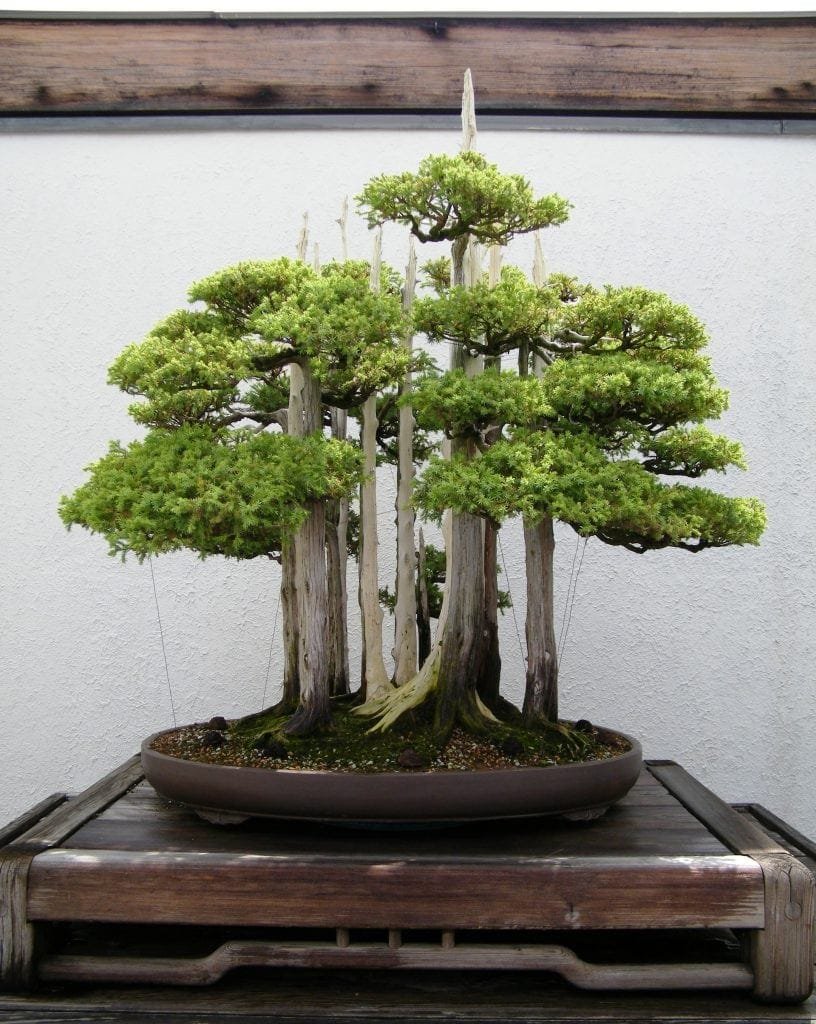
One of the most popular bonsai trees that are still alive today is the Goshin created by John Y. Naka. The Goshin was from the well-known eleven Foemina junipers and it is said that it was first refined in 1948. This bonsai was donated to the National Bonsai Foundation in 1984 and was placed on display at the United States Arboretum. The Goshin bonsai is made up of individual trees which represent Naka’s grandchildren.
The Goshin is possibly the most well-recognized bonsai in the United States and was one of the most recognized worldwide. The Goshin came together slowly over a long period of time. The first tree of the eleven forests is the smallest of the arrangement and is found at the back. The larger, younger and dominant trees came from Mr. Naka’s different presentations and demonstrations.
As you can see, the Goshin is a project that started out as a single tree until eventually, it became an 11-bonsai tree design. The very first of the 11 trees were tall and had only a few clumps of leaves. The first tree looked like a distressed tree without any plumes of leaves on the top. The bark was rough and the roots slightly uprooted. Eventually, after successfully growing a bonsai in 1963, Mr. Naka continued to create other trees and each time he was able to add more. Thus the birth of this beautiful bonsai design.
5) Pinus Silvestris
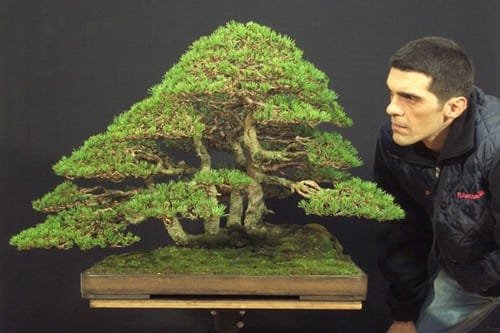
Pinus Silvestris is a bonsai tree species famous for its realistic appearance. Stefano Frisoni is responsible for the creation of this amazing bonsai tree. It has lush deep green foliage pads that look dense like a bunch of clouds floating in the sky. The Pinus silvestris is also known as Scotts Pine. It has an evergreen conical to flat top and is native to Europe from the cold lands of Norway to sunny Spain. It is also found in some parts of Asia in the cold zone to zone 2 which is ideal for bonsai cultivation.
This bonsai tree is also very popular because it can be grown and refined to fit different bonsai styles. It needs the full sun to grow but it also needs shade from the midday sun especially during the hot summer months. The Pinus silvestris prefers moist but not overwatered soil. You must reduce your water during winter time and let the soil dry out before you water.
Most growers love the Pinus silvestris because it is very rewarding to cultivate. Despite a lot of attention to pruning and wiring, the results will surely be very promising. New leaf growth should be pinched and not clipped. Pruning has to be done several times in spring. Major pruning and major structural work should be done during early fall to achieve the style you want easily. Be sure not to remove all the needles from a shoot because this will die back. It takes time and dedication to grow and design a Pinus silvestris as with all types of bonsai plants. Therefore you must have patience and good skills.
6) Rocky Mountain Juniper by Walter Pall
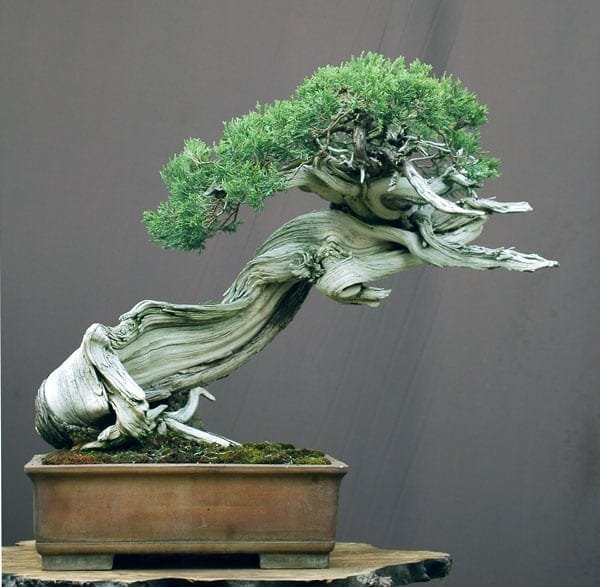
The Rocky Mountain Juniper bonsai created by Walter Pall has been the object of admiration. The famous bonsai grower has his own blog “Walter Pall Bonsai Adventures” where he writes about how he cares for famed juniper. The Rocky Mountain Juniper has won Pall the Crespi Cup Award in Italy. It won because of its amazing shape and realistic appearance. It was even regarded as one of the most beautiful bonsais in the world.
The Rocky Mountain Juniper by Walter Pall has a windswept appearance. The trunk looks dry yet a few plumes of gorgeous leaves occupy the top. The trunk twists several times to create this design possibly due to extensive wiring and years upon years of consistent redesign.
Aside from his Rocky Mountain Juniper, Walter Hall has also received awards from the Ginkgo Cup Awards in Belgium. He is also working on a comprehensive encyclopedia on bonsai. And aside from a bonsai grower and master, he is also a photographer and usually includes fantastic photos of his creations in his blog and in his presentation.
7) Acer Palmatum, Japanese Maple by Walter Pall
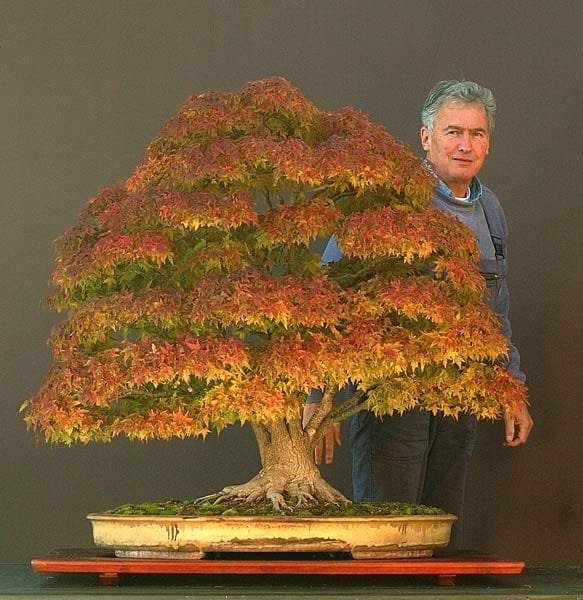
Another renowned bonsai created by master Walter Pall is the Acer Palmatum. This is a maple tree with a height of a meter; clearly one of the biggest bonsai trees in the world. The tree itself is said to be nearly 100 years old and has been refined and styled by Pall to show its hidden beauty.
Aside from being a prized bonsai, the Acer Palmatum has also won a number of awards such as the Art of Bonsai Photo Contest for its exceptional beauty. Walter Pall has created his own bonsai tree image and style instead of following traditional bonsai making methods.
Pall purchased this maple in Switzerland but it was a far cry from what it looks today. It was in a very neglected state. After purchasing the tree, the bonsai master has restored its good health and has significantly refined its branches and leaves. Now it is one of the most popular bonsai trees in Europe.
Walter Pall has admitted that this maple has a lot of flaws but he also pointed that the trick he used was to bring out the aura of the tree. He described the tree as a person with strong aura to hide major flaws. Pall has documented how he has maintained this tree and how it has regained its health and beauty from the time he purchased it until today. From an almost dying appearance to a magnificent maple tree, it is now one of the most popular and the most frequently photographed bonsais in the world.
8) Brazilian Rain Tree by Budi Sulistyo

From a small cutting to a great bonsai tree, the Brazilian Raintree has become one of the most popular tropical bonsai trees in the world. This species is native to central and South America where the area is highly humid and conducive to its growth. In the wild, the rain tree grows at a towering height but as a bonsai tree, it looks like a dainty miniature.
The Brazilian Rain Tree is also called Samanea saman, a gigantic tree that gives shade from the rain. Bonsai master Budi Sulistyo described his creation as having a perfectly balanced canopy that shimmers with life. The bonsai has a strong trunk and a lovely, perfectly-shaped canopy of leaves. The Brazilian Rain Tree trunk appears to be similar in appearance to trunks of old trees making it very realistic and at the same time artistic.
Several accounts online mentioned that Sulistiyo has grown his Brazilian Rain Tree from a small pencil-sized cutting. A lot of time and effort was sacrificed to cultivate the small cutting and now, the bonsai is healthy, thriving and beautiful.
9) Small Bonsai, Shohin Tree, Morten Albek
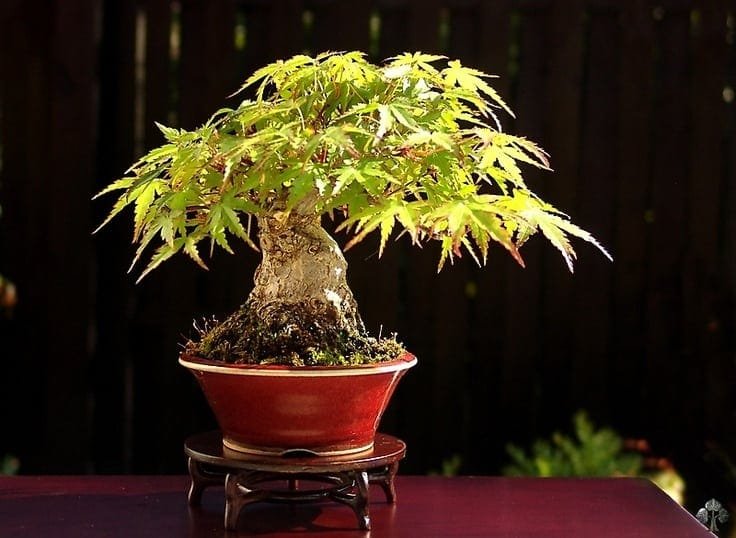
This small bonsai is a Rockspray Cotoneaster that grows very lovely tree flowers during the summer months. The lively tree flowers grow into red berries during the cold months. This bonsai is exceptional considering that it was planted in a miniature rock with a total height of 4 inches. Bonsai enthusiasts believe that this miniature is about 20 years old and have received training for the past ten years.
The Shohin Tree is not just popular for its beauty but for its ability to change in appearance season after season. Bonsai artist Morten Albek is behind this amazing piece of art. Albek is known for his hands on and online bonsai training classes. And being a popular and very talented artist, Albek was able to create a tree that looks very surreal and has the ability to transform its appearance season after season just like a regular tree.
Albek has created a strong online following for his tutorials, among them is appreciating lovely bonsai trees like the Shohin Tree. You will learn bonsai aesthetics, repotting, wiring and more from his online site.
Conclusion
Growing and cultivating bonsai takes patience and talent. Do you need inspiration and what could be more inspiring than these beautiful bonsai tree species? There are more amazing bonsai trees that you can take inspiration from but make sure to learn by heart techniques and various bonsai training strategies to give your trees tender loving care that these deserve.

